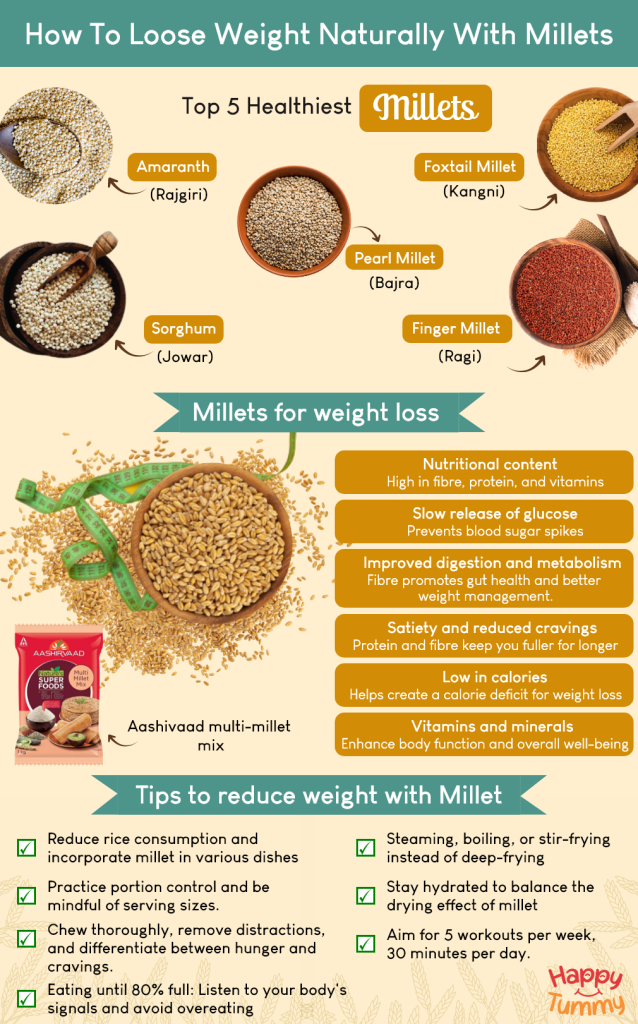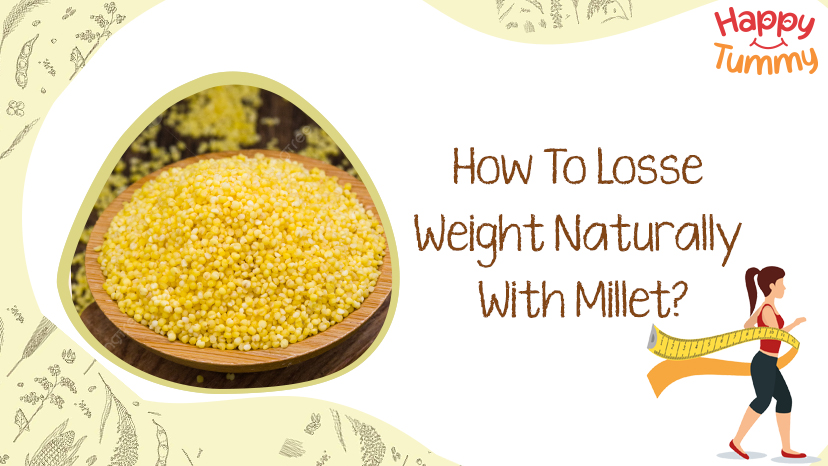Table of Contents
Life is a tough road, undoubtedly. And it becomes tougher when you have to walk with weight. A step here and you gasp, a step there and you gasp again. It becomes a terrible drag. And to make it easier, you hit the gym, run, swim, eat fat burners, and take the path that most people take — stop eating—however, the secret lies not in leaving but in picking the right foods. And one of those right food today is millet.
This unsung hero has been quietly waiting in the dark for his moment in the spotlight. And the moment is now. It is delicious, nutritious, and auspicious. So, why not dive in and see the ways of using millet for weight management?
But how does millet help to lose weight?
That is the right question and a good one.
Of course, you must know what millet does to aid your weight management.
What is so potent in these tiny grains that the digital air has suddenly taken a millety aroma? The answer lies in its nutritional content.
Millets contain nutrients that make favourable changes in the body. And when these changes harmonise with each other, a state of weight change happens. Here is a glimpse:
- Millet has complex carbohydrates and is low in glycemic index which helps maintain a steady glucose level and avoid sugar spike that aids in keeping you full for longer and manage hunger pangs.
- The fibre in millet makes stool bulky which leads to delayed gastric emptying thereby promoting satiety which helps control the calorie intake.
- Its fibre also multiplies the number of good gut bacteria. This means better digestion, better metabolism, and better weight.
- Its protein and fibre content keeps your craving on a halt for longer hours. Consequently, you don’t keep eating food all day.
- And of course, it is rich in vitamins and minerals that are critical to support bodily functions. The fibre in millet makes stool bulky which leads to delayed gastric emptying thereby promoting satiety which helps control the calorie intake. [1]
Now that you understand it works, let’s see how you can make it promote weight management.
Using millet to lose weight the right way!

Think of health, think of weight management, and think of millet. It’s an excellent trilogy. But a boon can also be a bane under the influence of misinformation. The same happens with millet. These grains indeed are potent enough to help you manage weight, but only when you do the right things.
The first thing to know is that there are many types of millet out there. Each of these types is different in terms of size, colour, taste, and nutrition. However, the difference is not mighty.
Among the many types of millet, there are a few that aid more than others toward weight management owing to their fibre content. Here are the top 5 healthiest millets that you may consider:
- Finger millet (Ragi)
- Sorghum (Jowar)
- Pearl Millet (Bajra)
- Amaranth (Rajgiri)
- Kodo Millet (Kodon)
- Little Millet (Kutki)
Fancy names, indeed, but names alone knowing can’t help until you buy and use them correctly. And how do we define this ‘correctly’?
Also, read – Millet names in different languages
1. Include millet in your daily diet
Add millet to your daily balanced diet across all your meals. Here are some of the ways to include millet in your daily diet.
- Prepare breakfast cereals using millet. The dishes may include ragi dosa, Jowar roti, Bajra roti, multi-millet chapati etc.
- Include millets in your meal & snack preparations such navane khichdi, kodo millet cutlets, millet pancakes etc.
- You can also include millets in sweet dish reparations such as puddings, payasam, cakes etc.
- Prepare malted beverages & smoothies out of millet.
- Add millet to your salad preparations
- You can also partially replace or add millet to some of the rice and wheat-based dishes such as kheer, pancakes, khichdi, Pongal, paratha etc., to increase its nutrition quotient.
The good thing about millet is that it is not a dull grain but a delicious one. You won’t believe the shades of taste it’ll add to your life, mention not the colours. Here are 6 ways you can cook millet to perfection (chef skills needed!):
- Turn rice pulao into millet pulav that has the richness of nutrients and delight of fresh veggies.
- Make a ‘Millet Buddha Bowl’ that is a Mexican-style assortment of veggies, legumes, and other protein-rich sources.
- Prepare a creamy and luscious risotto using millet instead of Arborio rice.
- Love rice-stuffed bell peppers? Can’t leave thinking about them? Replace rice with millet and you’ll then have a new toothsome love affair.
- And for the dessert part, replace rice kheer with millet kheer. Sweet!
Also, while cooking with millet (or anything), opt for healthier methods. Prepare millets using methods like steaming, boiling, or stir-frying instead of deep-frying. Avoid excessive use of oil or ghee. This is to keep a check on your calorie intake.
When cooking, opt for healthier cooking methods. Avoid deep frying.
2. Master the art of portion control
Millet has a tempting texture and taste. You never know how fast it becomes beloved from being a stranger grain. Today you eat it mindfully, but tomorrow you might lose your control. And losing control is a terrible thing, especially when driving or dieting.
Surely, millets are nutritious. But this does not mean you keep on eating it. While including it, keep a note of your calorie intake. Always be mindful of your serving sizes and ensure you’re not overeating. Remember that moderation is key. But hey! How do we know if overeating is creeping in? How much is too much?
Firstly, to ensure that you don’t overeat millet, take care of these things:
- Don’t jump onto the plate and stuff it down like a hamster. Take time to chew your food thoroughly and appreciate the flavours and textures. There is a gap between eating and the mind sending a signal that the belly is full. Eating quickly doesn’t allow our mind to signal “belly full” on time.
- Remove any distractions while eating. We know that smartphones are tempting, but they must not overtake the alluring nature of food. Our bodies fail to release appropriate digestive enzymes when the mind is distracted.
- There is a difference between ‘need to eat’ and ‘feel like eating’. Your stomach might start rumbling even a few hours after eating food. But this does not mean your body needs it. So, don’t eat every time you feel it in the stomach, especially when you’ve eaten your portion already.
Always eat mindfully and without any distractions. The general rule of thumb is to eat until 80% of your stomach is full.
3. Cherish the plate but properly hydrate
Water is the key to not just weight loss but good health as well. Don’t you ever skip your water intake. This becomes further important in the case of millet. Millets are high in fibre, and it is critical to ensure adequate hydration when on high-fibre diet to ensure proper digestion.
Aim for at least 2 litres or 8 glasses of water daily when doing nothing.
And when you are into athletic activities or eat food that has dry nature, increase the amount of water intake accordingly.
4. Get your feet moving
They say that weight loss is 75% diet and 25% workout. When you eat right, you treat right. So, when 75% of weight loss is about diet, what is the rest 25% about? It is about keeping our bodies on the move.
The modern lifestyle has become ultra-sedentary. This has put us at risk of health issues more than ever in history. We have not evolved to sit on the couch all day. Our bodies do not function that way. We, once hunters and gatherers, have evolved to keep moving.
So, apart from eating millet-made dishes, aim to include working out in your lifestyle. And to what extent?
Try working out a minimum of , 30 minutes a day for 5 times a week.
It could be as light as brisk walking, as moderate as jogging, dancing, a light workout or as playful as football.
Conclusion
The current buzz around millet is not a passing fancy. It is not a hollow reed that will fall after mere metres. No! We have been eating millet traditionally for a long. This healthy grain was once as dear as any other family member. Now it is time to bring it back. Surely millet serves abundant benefits to health and happiness. One of those benefits is its weight management property.
Don’t hesitate if you look to include millet in your weight management journey. It is rich in fibre, protein, vitamins, nutrients, and antioxidants. All these things have their credible say in reducing weight. However, the secret also lies in how you eat it. Don’t completely depend on it. Rather, make it a part of your balanced diet. Also, don’t overeat, don’t fry, and don’t cry if you are a bad chef. You’ll learn gradually. To begin with, you can add the Aashivaad multi-millet mix to your regular atta. You’ll enjoy the benefits of millets while savouring your rotis. This way, you can gradually move to eat millet in meals.
Celebrate the wonders of millet, my friend, and toast to your well-being. Cheers to a healthier, happier you!
FAQs
Yes, including millet in your diet can aid in weight management. Millet is a nutrient-dense grain that is rich in fibre. The high fibre content helps you feel fuller for longer, reduces hunger cravings, and promotes healthy digestion, which can contribute to weight management.
While millet can support weight management, it is important to adopt a holistic approach for a sustainable and healthy weight management journey. Combine millets with a balanced diet that includes a variety of fruits, vegetables, lean proteins, and healthy fats. Also, incorporate regular exercise and portion control to create a calorie deficit and achieve ideal weight management over time.
Traditionally millets have been consumed as a part of daily diets across regions such as Bajra in the North, Ragi in the South, etc. Eating millet daily can have several positive effects on your health. Millets are rich in nutrients such as fibre, protein, vitamins, and minerals, which support overall well-being. They can improve digestion, regulate blood sugar levels, enhance heart health, boost immunity, and contribute to weight management.
Scientifically, spot reduction does not occur in the body, reduction of fat occurs in an overall holistic manner and is specific to each individual. Millet plays a role in the weight management journey as the high fibre content in millet helps in controlling appetite and reducing overall calorie intake. Combining millet with a balanced diet and regular exercise is key to weight management.
Yes, it is fine to include millet in your dinner or evening meals. Millets are a good source of complex carbohydrates, which provide sustained energy and can help prevent late-night cravings. However, portion control is important to maintain a balanced calorie intake, especially if you are aiming for weight management.
Mixing different types of millet in your diet can be a great way to enjoy a variety of flavours and nutrients. Each millet has its unique nutritional profile, and combining them can provide a wider range of health benefits. However, it is important to ensure proper cooking and portion control while incorporating a mix of millet into your meals. An easy way to include millet in your diet is by mixing Aashivaad multi-millet mix with your regular rotis to enjoy the taste and health benefits.
















